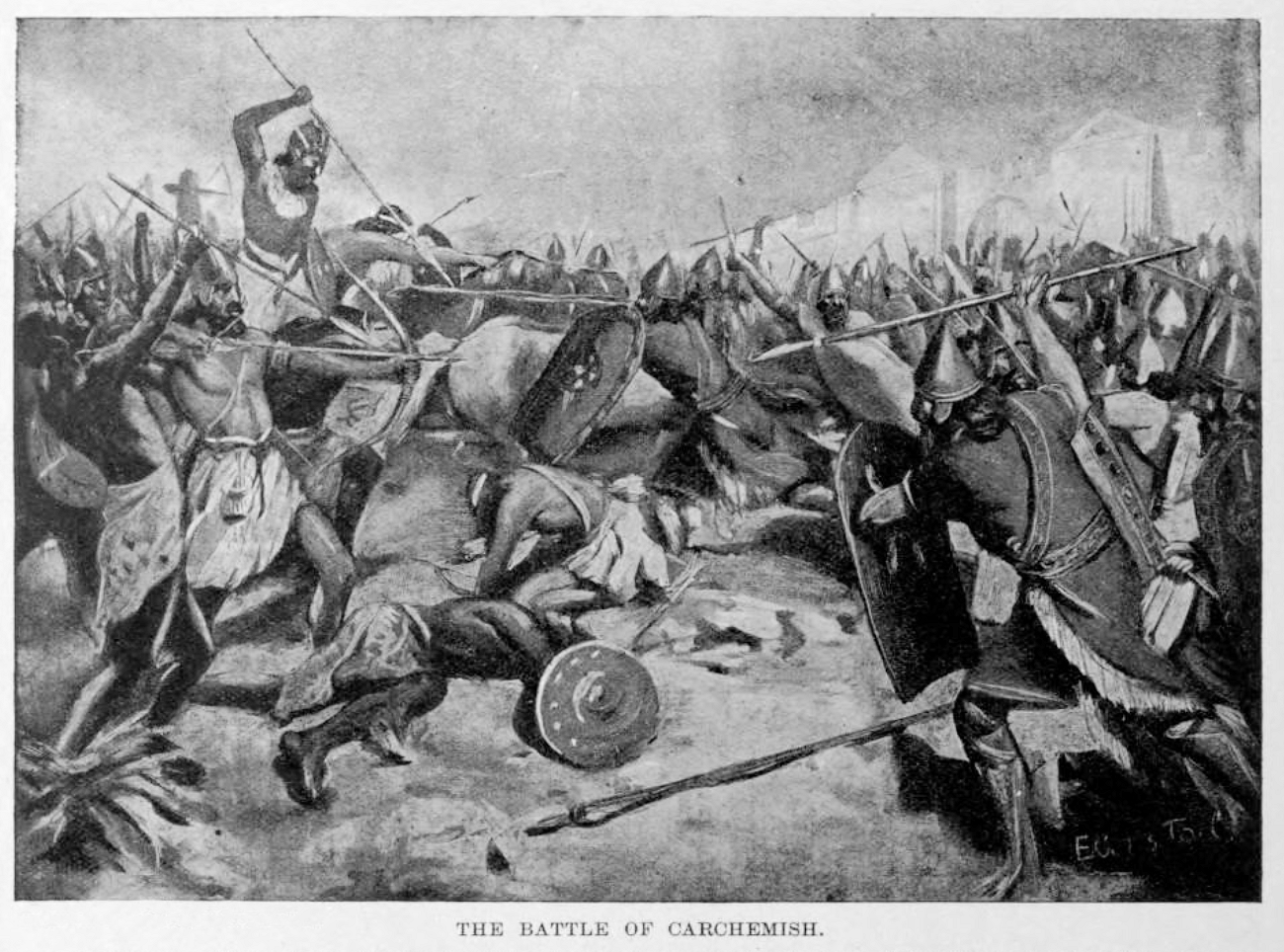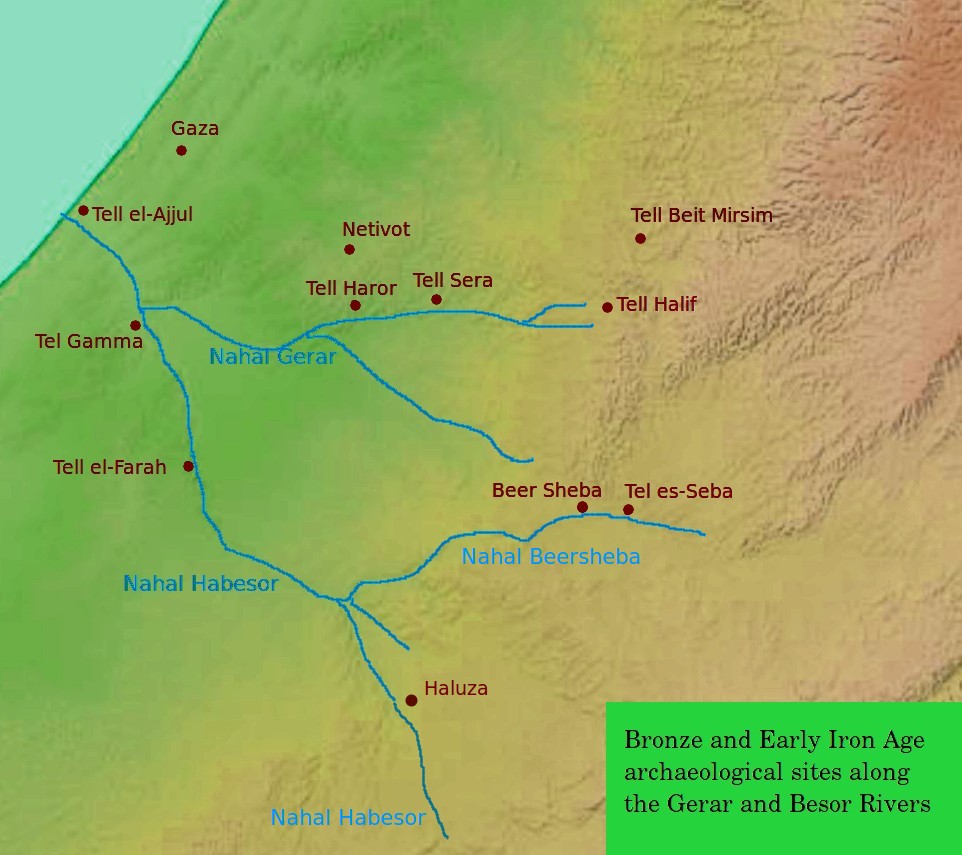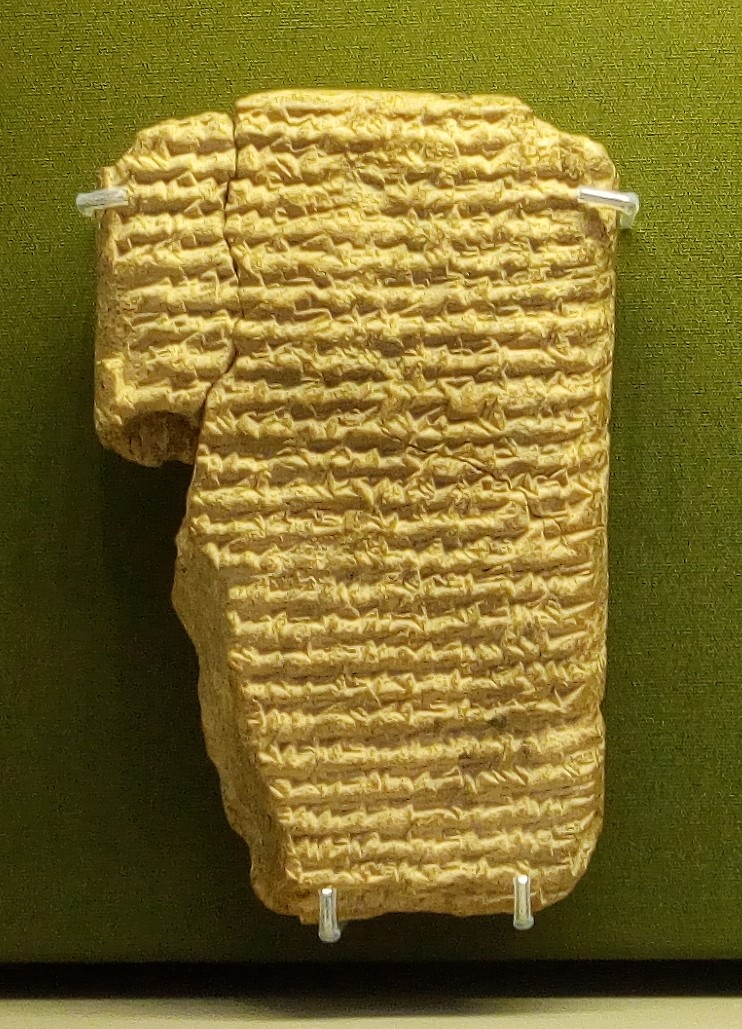|
Mesad Hashavyahu
Meṣad Hashavyahu is an ancient fortress on the border of the Iron Age Kingdom of Judah facing the Philistine city of Ashdod near the Mediterranean Sea. It lies south of the seaport Yavne-Yam (the seaport) and northwest of the main city of Yavne. The original name of the fort is unknown but was given the name found on several inscribed ostraca recovered at the site. The site covers an area of approximately . The Yavne-Yam ostracon was found in the excavations. History The fortress dates from approximately 630 BCE to 609 BCE, within the reigning years of Josiah, Kingdom of Judah, king of Judah. William F. Albright wrote, "The life of the fortress could be dated within narrow limits by the typical late pre-exilic and early Ionic vase painting, Ionian pottery found on the site, as well as by historical considerations, which suggest a date about 630 BCE. This would be just after the death of the Assyrian king Ashurbanipal and before the occupation of the Philistia, Philistine Plain ... [...More Info...] [...Related Items...] OR: [Wikipedia] [Google] [Baidu] [Amazon] |
Palmachim
Palmachim () is a kibbutz in central Israel. Located about ten kilometers south of the Gush Dan, Tel Aviv area along the coast of the Mediterranean Sea, among the sand dunes, it falls under the jurisdiction of Gan Raveh Regional Council. In it had a population of . History Palmachim was established on 11 April 1949 by former members of the Palmach underground organization's Yiftach Brigade, on land of the List of villages depopulated during the Arab-Israeli conflict, depopulated Palestinians, Palestinian village of Nabi Rubin. In 2004 the kibbutz underwent privatization. In 2006 former residents of Elei Sinai, an Israeli settlement in the Gaza Strip evicted during the Israeli disengagement from Gaza, disengagement plan protested to the Cabinet of Israel, government until they were allowed to move to the kibbutz. In 2011, 25 families evicted from Elei Sinai (48 persons) were accepted as members to the kibbutz. In 2013, they began building their homes in Palmachim. Economy Th ... [...More Info...] [...Related Items...] OR: [Wikipedia] [Google] [Baidu] [Amazon] |
Ionic Vase Painting
Ionic vase painting was a regional style of ancient Greek vase painting. Ionia first becomes noticeable as a separate region within East Greek vase painting during the final phase of the Orientalising style, when the black-figure incision style spread from Northern Ionia throughout East Greece. In the later phase of the Wild Goat style, Northern Ionian artists imitated Corinthian vases, if rather poorly. Ionia had been producing high quality pottery already since the 7th century BC. Since about 600 BC, the black-figure style was used to decorate all or part of vases. Apart from gradually developing local styles (e.g. at Clazomenae, Ephesos, Miletus, Chios and Samos), especially northern Ionia developed a variety of distinctive styles, the locations of which cannot be asserted at present. Perfume vessels based on the Lydian ''lydion'' shape, decorated merely with stripes, were widespread. Some of the images are highly original, such as a Scythian with a Bactrian camel, or a s ... [...More Info...] [...Related Items...] OR: [Wikipedia] [Google] [Baidu] [Amazon] |
Iron Age Sites In Israel
Iron is a chemical element; it has symbol Fe () and atomic number 26. It is a metal that belongs to the first transition series and group 8 of the periodic table. It is, by mass, the most common element on Earth, forming much of Earth's outer and inner core. It is the fourth most abundant element in the Earth's crust, being mainly deposited by meteorites in its metallic state. Extracting usable metal from iron ores requires kilns or furnaces capable of reaching , about 500 °C (900 °F) higher than that required to smelt copper. Humans started to master that process in Eurasia during the 2nd millennium BC and the use of iron tools and weapons began to displace copper alloys – in some regions, only around 1200 BC. That event is considered the transition from the Bronze Age to the Iron Age. In the modern world, iron alloys, such as steel, stainless steel, cast iron and special steels, are by far the most common industrial metals, due to their mechanical proper ... [...More Info...] [...Related Items...] OR: [Wikipedia] [Google] [Baidu] [Amazon] |
Buildings And Structures Completed In The 7th Century BC
A building or edifice is an enclosed structure with a roof, walls and windows, usually standing permanently in one place, such as a house or factory. Buildings come in a variety of sizes, shapes, and functions, and have been adapted throughout history for numerous factors, from building materials available, to weather conditions, land prices, ground conditions, specific uses, prestige, and aesthetic reasons. To better understand the concept, see ''Nonbuilding structure'' for contrast. Buildings serve several societal needs – occupancy, primarily as shelter from weather, security, living space, privacy, to store belongings, and to comfortably live and work. A building as a shelter represents a physical separation of the human habitat (a place of comfort and safety) from the ''outside'' (a place that may be harsh and harmful at times). buildings have been objects or canvasses of much artistic expression. In recent years, interest in sustainable planning and building pract ... [...More Info...] [...Related Items...] OR: [Wikipedia] [Google] [Baidu] [Amazon] |
Israel Finkelstein
Israel Finkelstein (; born March 29, 1949) is an Israelis, Israeli archaeologist, professor emeritus at Tel Aviv University and the head of the School of Archaeology and Maritime Cultures at the University of Haifa. Finkelstein is active in the archaeology of the Levant and is an applicant of archaeological data in reconstructing biblical history. Finkelstein is the current excavator of Tel Megiddo, Megiddo, a key site for the study of the Bronze Age, Bronze and Iron Age, Iron Ages in the Levant. Finkelstein is a member of the Israel Academy of Sciences and Humanities an ''associé étranger'' of the French Académie des Inscriptions et Belles-Lettres, and International Honorary Member of the American Academy of Arts and Sciences. In 2005, he won the Dan David Prize for his study of the history of Israel in the 10th and 9th centuries BCE. In 2009 he was named ''chevalier'' of the ''Ordre des Arts et des Lettres'' by the French Minister of Culture, and in 2010, received a Doctorate ... [...More Info...] [...Related Items...] OR: [Wikipedia] [Google] [Baidu] [Amazon] |
Yohanan Aharoni
Yohanan Aharoni (; 7 June 1919 – 9 February 1976) was an Israeli archaeologist and historical geographer, chairman of the Department of Near East Studies and chairman of the Institute of Archaeology at Tel Aviv University. Life Born to the Aronheim family, in Germany on 7 June 1919, Aharoni immigrated to Mandatory Palestine in 1933. He studied at the Hebrew Reali School in Haifa, and later at the Mikve Yisrael agricultural school. He married Miriam Gross and became a member of kibbutz Alonim, where he lived until 1947. Career Aharoni studied archaeology at the Hebrew University of Jerusalem and began to teach there in 1954. By 1966, he became a professor at the university. However, in 1968, he moved to Tel Aviv University and replaced Shemuel Yeivin as chairman of the Department of Near East Studies. Together with his student Moshe Kochavi, his academic staff from his archaeological projects, and the teaching staff of the Department, Aharoni established the Tel Aviv Uni ... [...More Info...] [...Related Items...] OR: [Wikipedia] [Google] [Baidu] [Amazon] |
Twenty-sixth Dynasty Of Egypt
The Twenty-sixth Dynasty of Egypt (notated Dynasty XXVI, alternatively 26th Dynasty or Dynasty 26) was the last native dynasty of ancient Egypt before the Persian conquest in 525 BC (although other brief periods of rule by Egyptians followed). The dynasty's reign (664–525 BC) is also called the Saite Period after the city of Sais, where its pharaohs had their capital, and marks the beginning of the Late Period of ancient Egypt.Aidan Dodson, Dyan Hilton. ''The Complete Royal Families of Ancient Egypt''. The American University in Cairo Press, London 2004 History This dynasty traced its origins to the Twenty-fourth Dynasty. Psamtik I was probably a descendant of Bakenranef. However, other sources describe him as of Libyan descent. Following the Neo-Assyrian conquest of Egypt during the reigns of Taharqa and Tantamani, and the subsequent collapse of the Napata-based Twenty-fifth Dynasty of Egypt, Psamtik I was recognized as sole king over all of Egypt. Psamtik formed alli ... [...More Info...] [...Related Items...] OR: [Wikipedia] [Google] [Baidu] [Amazon] |
Ancient Greece
Ancient Greece () was a northeastern Mediterranean civilization, existing from the Greek Dark Ages of the 12th–9th centuries BC to the end of classical antiquity (), that comprised a loose collection of culturally and linguistically related city-states and communities. Prior to the Roman period, most of these regions were officially unified only once under the Kingdom of Macedon from 338 to 323 BC. In Western history, the era of classical antiquity was immediately followed by the Early Middle Ages and the Byzantine period. Three centuries after the decline of Mycenaean Greece during the Bronze Age collapse, Greek urban poleis began to form in the 8th century BC, ushering in the Archaic period and the colonization of the Mediterranean Basin. This was followed by the age of Classical Greece, from the Greco-Persian Wars to the death of Alexander the Great in 323 BC, and which included the Golden Age of Athens and the Peloponnesian War. The u ... [...More Info...] [...Related Items...] OR: [Wikipedia] [Google] [Baidu] [Amazon] |
Ancient Near Eastern Texts Relating To The Old Testament
''Ancient Near Eastern Texts Relating to the Old Testament'' edited by James B. Pritchard (1st ed. 1950, 2nd ed.1955, 3rd ed. 1969) is an anthology of important historical, legal, mythological, liturgical, and secular texts in biblical archaeology. Description In spite of the name, the included texts have broad coverage and do not necessarily relate to the Old Testament. William W. Hallo, writing in the ''Journal of the American Oriental Society'' in 1970, described it as "a modern classic ever since its first appearance in 1950", because "for the first time it assembled some of the most significant Ancient Near Eastern texts in authoritative, generously annotated English translations based on the accumulated insight of several generations of scholarship scattered". It is conventional to cite the work as ANET. ANEP refers to a companion volume ''Ancient Near Eastern Pictures Relating to the Old Testament'' (1st ed. 1954, 2nd ed. 1969), featuring 882 black and white designs an ... [...More Info...] [...Related Items...] OR: [Wikipedia] [Google] [Baidu] [Amazon] |
Psamtik I
Wahibre Psamtik I (Ancient Egyptian: ) was the first pharaoh of the Twenty-sixth Dynasty of Egypt, the Saite period, ruling from the city of Sais in the Nile delta between 664 and 610 BC. He was installed by Ashurbanipal of the Neo-Assyrian Empire, against the Kushite rulers of the Twenty-fifth Dynasty, but later gained more autonomy as the Assyrian Empire declined. Name The Egyptian name , pronounced as , was a short form of , meaning "the man of Meṯek", with Meṯek presumably a deity. His name was rendered by the Assyrians as Pishamilki (), by the Ancient Greeks as (), and by the Romans as . Psamtik was also called Nabu-shezibanni ( and ), meaning "O Nabu, save me!" by the Assyrians. Background In 671 BCE, the Assyrian king Esarhaddon invaded Egypt. This invasion was directed against the Kushite rulers of the Twenty-fifth Dynasty of Egypt, who had been in control of Upper Egypt, rather than against the native Egyptian rulers. The Assyrians created an admin ... [...More Info...] [...Related Items...] OR: [Wikipedia] [Google] [Baidu] [Amazon] |
Philistia
Philistia was a confederation of five main cities or pentapolis in the Southwest Levant, made up of principally Gaza, Ashkelon, Ashdod, Ekron, Gath, and for a time, Jaffa (part of present-day Tel Aviv-Yafo). Scholars believe the Philistines were made up of people of an Aegean background that from roughly 1200 BC onwards settled in the area and mixed with the local Canaanite population, and came to be known as '' Peleset'', or Philistines. At its maximum territorial expansion, its territory may have stretched along the Canaanite coast from Arish in the Sinai (today's Egypt) to the Yarkon River (today's Tel Aviv), and as far inland as Ekron and Gath. Nebuchadnezzar II invaded Philistia in 604 BC, burned Ashkelon, and incorporated the territory into the Neo-Babylonian Empire; Philistia and its native population the Philistines disappear from the historic record after that year. History Ancient Egyptian hieroglyphic records from the New Kingdom period record a group of ... [...More Info...] [...Related Items...] OR: [Wikipedia] [Google] [Baidu] [Amazon] |
Ashurbanipal
Ashurbanipal (, meaning " Ashur is the creator of the heir")—or Osnappar ()—was the king of the Neo-Assyrian Empire from 669 BC to his death in 631. He is generally remembered as the last great king of Assyria. Ashurbanipal inherited the throne as the favored heir of his father Esarhaddon; his 38-year reign was among the longest of any Assyrian king. Though sometimes regarded as the apogee of ancient Assyria, his reign also marked the last time Assyrian armies waged war throughout the ancient Near East and the beginning of the end of Assyrian dominion over the region. Esarhaddon selected Ashurbanipal as heir 673. The selection of Ashurbanipal bypassed the elder son Shamash-shum-ukin. Perhaps in order to avoid future rivalry, Esarhaddon designated Shamash-shum-ukin as the heir to Babylonia. The two brothers jointly acceded to their respective thrones after Esarhaddon's death in 669, though Shamash-shum-ukin was relegated to being Ashurbanipal's closely monitored vassal. Mu ... [...More Info...] [...Related Items...] OR: [Wikipedia] [Google] [Baidu] [Amazon] |







